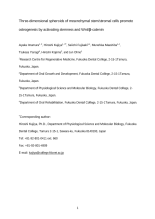Three-dimensional spheroids of mesenchymal stem/stromal cells promote osteogenesis by activating stemness and Wnt/β-catenin. Three-dimensional spheroids of mesenchymal stem/stromal cells promote osteogenesis by activating stemness and Wnt/β-catenin.
Access this Article
Author
Bibliographic Information
- Title
-
Three-dimensional spheroids of mesenchymal stem/stromal cells promote osteogenesis by activating stemness and Wnt/β-catenin.
- Other Title
-
Three-dimensional spheroids of mesenchymal stem/stromal cells promote osteogenesis by activating stemness and Wnt/β-catenin.
- Author
-
Imamura, Ayaka
- Author
-
Kajiya, Hiroshi
- Author
-
Fujisaki, Seiichi
- Author
-
Maeshiba, Munehisa
- Author
-
Yanagi, Tsukasa
- Author
-
Kojima, Hiroshi
- Author
-
Ohno, Jun
- University
-
福岡歯科大学
- Types of degree
-
博士(歯学)
- Grant ID
-
甲第317号
- Degree year
-
2020-03-14
Note and Description
Mesenchymal stem/stromal cells (MSCs) are multipotent and self-renewal cells that are widely used in regenerative medicine. The culture of three-dimensional (3D) spheroid MSCs more accurately mimics the biological microenvironment. However, it is unclear which key molecules are responsible for the cell fate control of MSCs during 3D spheroid formation and their impact on the functional characteristics of these stem cells. Furthermore, it remains unclear what effects 3D spheroid MSC transplantation has on new bone formation compared with that of 2D monolayer MSCs. We assessed whether the osteogenerative potential of 3D spheroid MSCs is greater than that of 2D monolayer MSCs invitro. In addition, to elucidate the ability of 3D spheroid MSCs to regenerate bone, we examined the effects of transplanting wild-type (WT) or knockout (KO) spheroid MSCs on new bone formation in mice calvarial defect model invitro. The 3D spheroid MSC culture dramatically upregulated into stemness markers compared with the 2D monolayer MSC culture. In contrast, BMP-2 significantly increased the osteogenesis-related molecules in the 3D spheroid MSCs but, in turn, downregulated the stemness markers. BMP-2 activated Smad1/5 together with Wnt/β-catenin in 3D spheroid MSCs. Transplantation of these MSCs into aged mice with calvarial defects promoted new bone formation compared with that of 2D monolayer MSCs. In contrast, transplantation of 3D or 2D β-catenin knockout MSCs induced little new bone formation. The 3D spheroid MSC culture had higher stemness compared with the 2D monolayer MSC culture. The culture of 3D spheroid MSCs rapidly promoted osteoblastogenesis and bone formation through synergistic activation of the Wnt/β-catenin pathway invitro. The transformation of 3D spheroid, but not 2D monolayer, MSCs promoted new bone regeneration invivo. These results indicate that transplantation of 3D spheroid MSCs in regeneration therapy contributes to a shorter regenerative healing process, including new bone formation.
2019年度
元資料の権利情報 : CC BY-NC-ND
https://doi.org/10.1016/j.bbrc.2019.12.066
